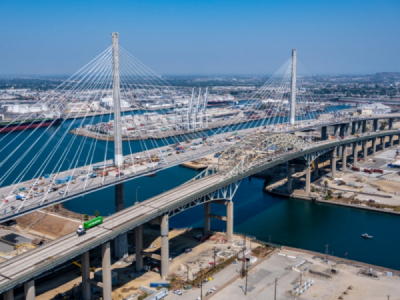
Posted on October 7, 2020
It’s longer, wider and taller.
And with the new, cable-stayed bridge poised to open for business at the Port of Long Beach on Monday, Oct. 5, those expanded dimensions will translate to more jobs for the region and an economic boost for both Southern California and the nation as a whole, port officials say.
The “Bridge to Everywhere,” as port officials have taken to calling it, replaces the existing Gerald Desmond Bridge, which has served the port for more than 50 years but was rapidly becoming obsolete. The new structure has yet to be officially named.
But Noel Hacegaba, the port’s deputy executive director, wouldn’t disagree with the description of the Gerald Desmond’s successor as the “Bridge to Everywhere.”
“We’re not only a gateway, but a facilitator of global trade that impacts the entire nation,” he said. “This new bridge is part of a larger infrastructure program we’ve been embarking on for the last 10 years. It will go a long way toward our ability to remain competitive.”
Underscoring the port’s national importance — it’s the second largest in the United States, behind the neighboring Port of Los Angeles — the trade hub has managed to stay busy despite fallout from the coronavirus pandemic.
“Even in this very turbulent year, we’re only down 1.2% year to date through August,” Hacegaba said. “We’re still handling a lot of cargo.”
Bigger and better
The new bridge has a leg up on the Gerald Desmond in several respects.
It’s not nearly as steep, which will be safer as heavy freight-loaded trucks pass over its span, and it has six lanes in each direction compared with four on the old bridge. That will accommodate significantly more vehicle traffic.
Hacegaba said the increased height will also allow today’s bigger cargo ships to pass beneath, fueling an influx of new business.
The new bridge is 205 feet tall compared to 155 feet for the Gerald Desmond. The extra height is needed, port officials say, as many of today’s modern cargo ships routinely carry 18,000 20-foot-equivalent units of freight; TEU is a universal measurement for cargo, though most containers today are 40 feet.
“To put it in context, a ship of that size is the equivalent of a 12-lane freeway in width and is as long as the Empire State Building and as high as a 10-story building,” Hacegaba said. “And we’ll be the only port in the U.S. that can handle even bigger ships with 23,000 TEUs.”
For comparison, the largest ships that can pass through the Panama Canal’s recently expanded locks carry 14,000 TEUs.
“This gives us a competitive advantage,” Hacegaba said.
Economic engine and job creator
The Port of Long Beach is a major economic engine for both Southern California and the nation. The complex handles about $170 billion in trade each year and supports more than 50,000 jobs in Long Beach alone.
“Regionally, it’s nearly 600,000 jobs and nationwide, it’s a total of 2.6 million jobs,” Hacegaba said.
Those jobs generate more than $126.8 billion in wages, and all of that activity pours an additional $374 billion in spending into the national economy.
Phillip Sanfield, spokesperson for the Port of Los Angeles, said his facility will also benefit from the new bridge.
“It’s an important piece of infrastructure that will provide more highway capacity to both ports and increase safety for trucks and autos,” he said. “Any major infrastructure improvement in the San Pedro Bay is good for cargo moving in and out, whether it’s an improvement in railways, roadways or waterways.”
Other upgrades
The Port of Long has two additional infrastructure projects underway:
- The $1.8 billion Middle Harbor Terminal redevelopment project will combine two aging shipping terminals into one of the world’s most advanced and greenest container terminals. It’s scheduled to be completed by the first quarter of 2021.
- The $870 million Pier B On-Dock Rail Support Facility will enhance on-dock rail capacity at the port’s shipping terminals, speeding the movement of cargo via train and strengthening the port’s competitiveness. The first arrival, departure and storage tracks are expected to be completed in 2024, with full project completion in 2032.
Long Beach Councilmember Roberto Uranga said a new bridge was sorely needed.
“The old bridge had lived its life,” he said. “It was falling apart with pieces of concrete coming off. It was either retrofit the bridge or replace it.”
“And with the increasing size of ships that can carry more TEUs,” Uranga added, “the decision was made 10 years ago to replace it.”
A joint effort
Construction on the $1.47 billion project began in 2013 as a joint effort between the Port of Long Beach and Caltrans, with additional funding from the U.S. Department of Transportation and Los Angeles County Metropolitan Transportation Authority.
That price tag includes the eventual demolition of the existing Gerald Desmond Bridge, which is adjacent to the new structure.
The cost, though, is worth it, officials said.
“This reduces friction in our trade sector, which is incredibly important for creating jobs in the region,” said Lawren Markle, spokesman for the Los Angeles County Economic Development Corp. “We’ve excited to see this come online because trade is so integral to L.A.’s economy.”
Hacegaba, for his part, said the bridge will help move the Port of Long Beach forward.
“Every container that crosses that bridge supports our economy by creating jobs,” he said. “It’s important for us to invest in our infrastructure. That’s the key to our future.”
Source: presstelegram





